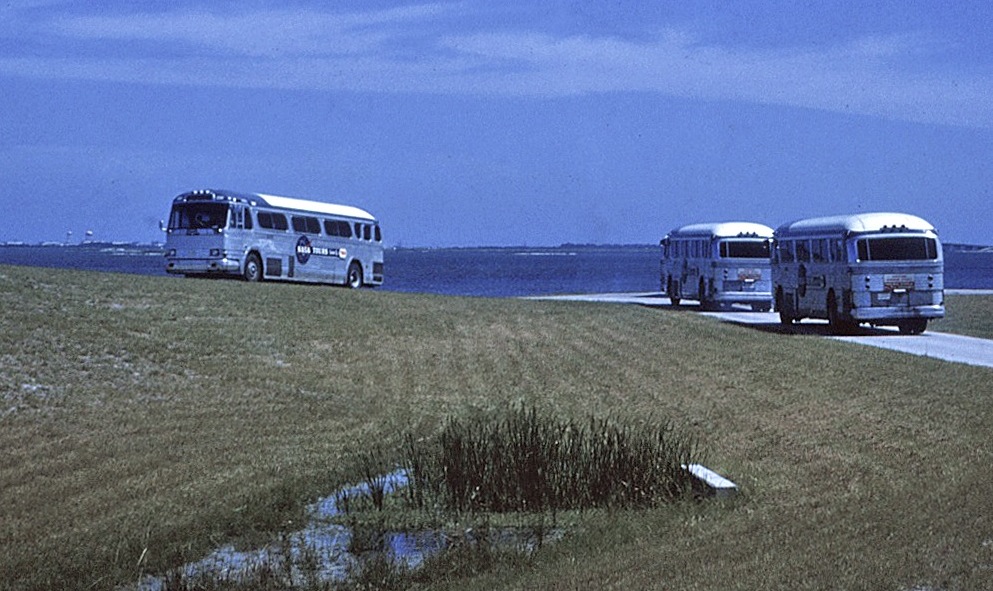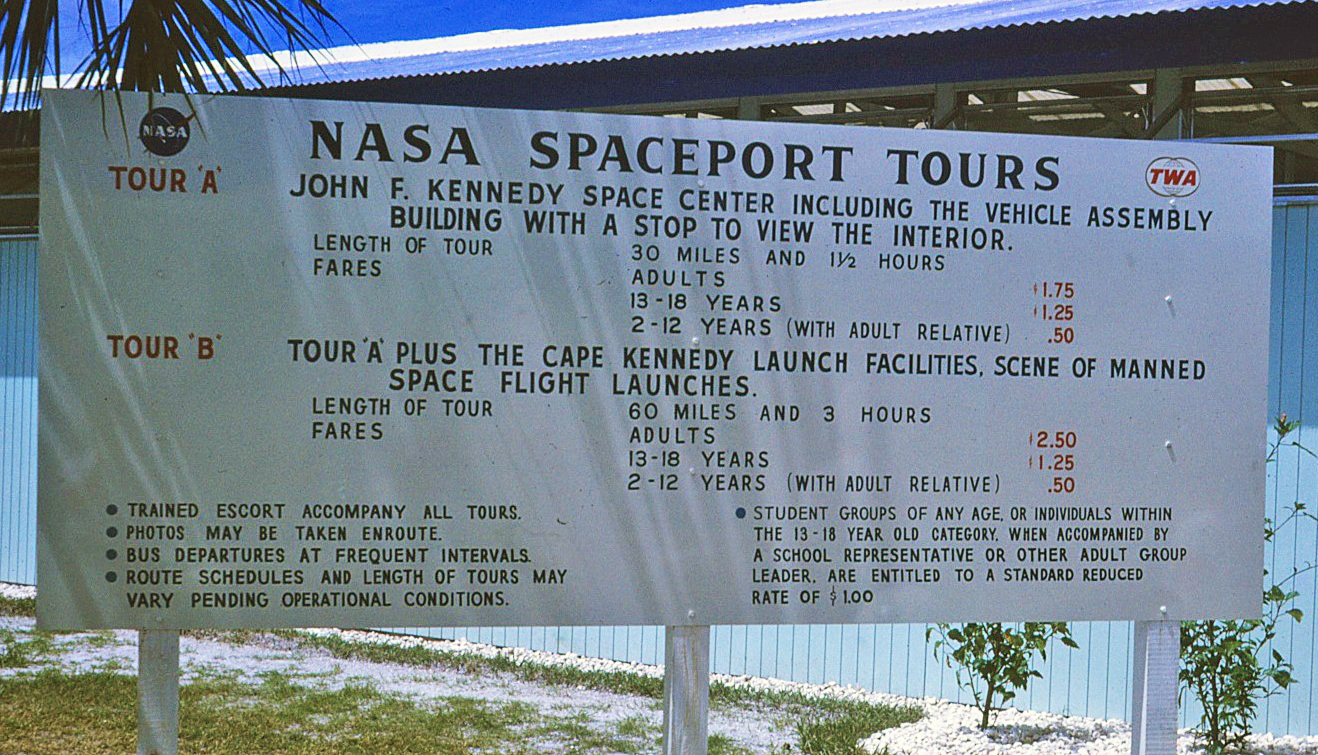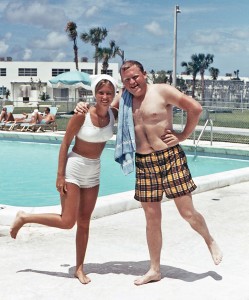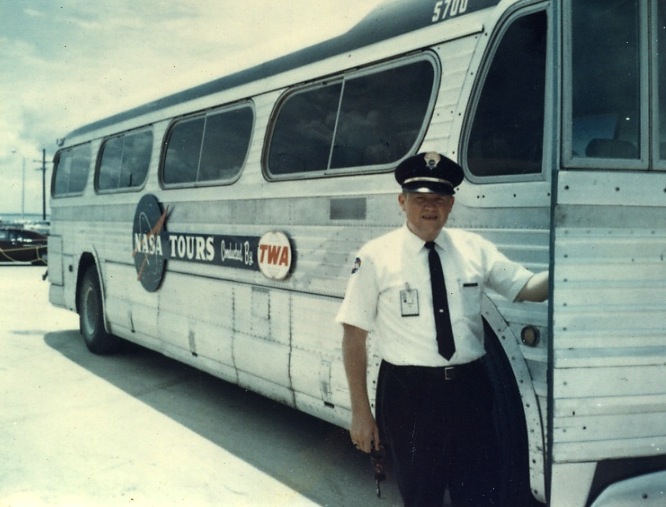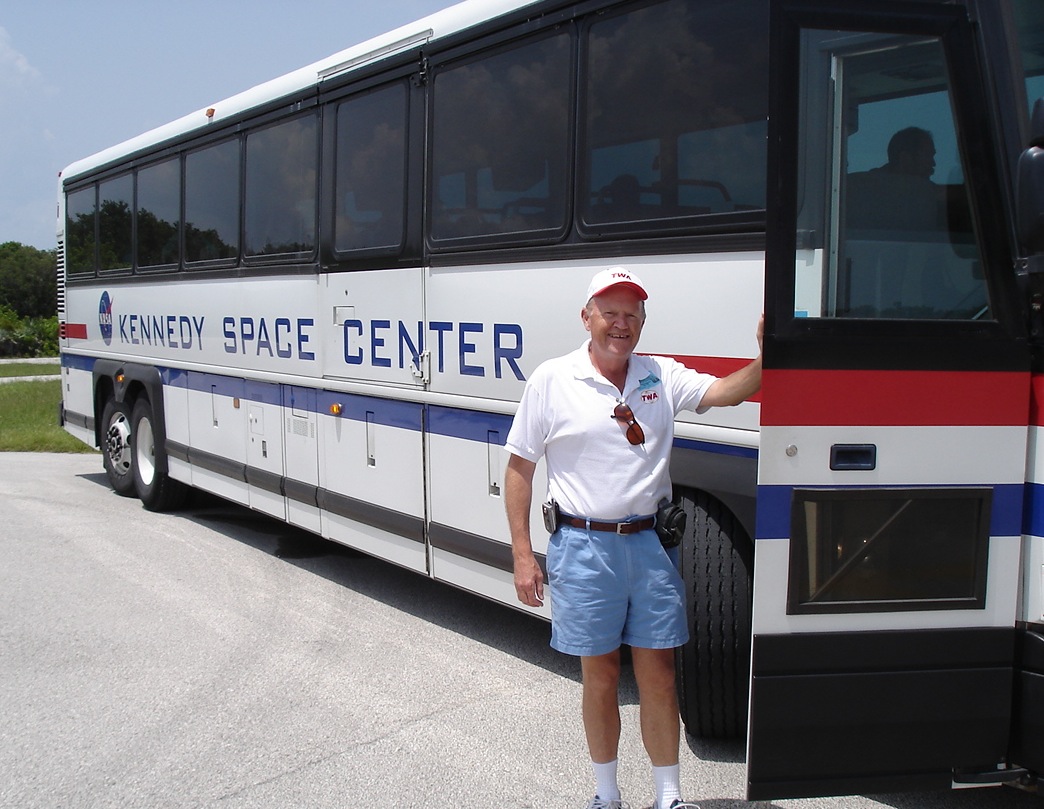1966 – Kennedy Space Center
By early 1966, I was able to hold some day-shift assignments, albeit on vacation relief, which also included a week here and there on mids, and a few stints in Lost & Found. However, it was nice to have evenings free once in awhile and even an occasional weekend off.
The 1966 summer schedule featured more flights, increased activity and new hires. In addition, we had schoolteachers on the ticket counter, a great program that allowed them to work during Christmas and Easter vacations as well, when the extra staffing was most welcome. Several teachers had been doing this double duty for multiple years and needed little retraining; they were invaluable.
Be sure to click in individual pictures for larger images.
“Welcome: You’re on the Threshold of Space!”
Just a bit more historical background will help to set the stage here, for my next adventure.
In 1964, TWA was awarded a contract to provide base support at the 88,000-acre John F. Kennedy Space Center (KSC). Originally known as the Merritt Island Launch Area (MILA), the complex was built adjacent to the Cape Canaveral Air Force Station to carry out the President’s goal of landing a man on the Moon by the end of that decade. Initially, TWA’s responsibilities included general maintenance, utilities and supply operations, in addition to fire protection and prevention, security and medical services. Over the life of the contract, more than 2,000 TWA employees were assigned to KSC.
It was decided in 1966 to provide public tours of the Space Center and the Cape Kennedy, the latter having been renamed from Cape Canaveral in 1963 (its original name was restored in 1973). TWA was awarded the tour contract. This is where I come into the story.
I had just over two years of seniority with TWA when a job-opening bulletin was posted in May, for the position of “Space Center Escort – Kennedy Space Center Florida.” Dated May 10, it read, in part:
“Duties: Conduct visitor tours of the Kennedy Space Center. Provide appropriate and expert commentary on all aspects of the Space program including discussions of the history, missions, organization technical operation and facilities. Answer all visitors’ questions. Keep constantly abreast on new developments and update lecture material. Be solely responsible for the conduct of the tour including providing for comfort, safety and individual needs of the visitors. Operate a 40-passenger bus. Work combinations of shifts and days since the tours will be on a 7-day-per-week basis. Comprehensive training will be conducted at the Kennedy Space Center prior to operational assignment.”
“Qualifications: Must be a high school graduate; 2 years of college desired. Should have experience dealing with the public on a service basis. Must exhibit a high degree of tact, poise, enthusiasm and ability to deal effectively with all types of people individually and in large groups.”
“Closing date: May 16, 1966.”
The job sounded exciting, with a chance to be right in the middle of the Space race; the Gemini program in full swing. I applied immediately. A day later, Cal Filson, a veteran TWAer in the industrial relations department, interviewed me for the job. He must have been impressed with my enthusiasm, because I was awarded one of 10 openings on May 31, along with a $24 monthly salary increase to $585. With the transfer came a one-year commitment to remain in the new location.
Excitedly, I headed across the country in my 1965 Volkswagen, stopping in Las Cruces, New Mexico, Fort Worth and New Orleans before reaching brother Dick’s home in Winter Park, Florida. I reported at the Space Center on June 19.
I never did find out how many people applied for the job, but I was one of 10 who quickly got to know the other nine; all had been TAs, from all across the TWA domestic system:
- Elliot Bakst – New York JFK
- Wray Brabson – Washington National
- John Edmonds – Kanas City
- Bob Farrar – St Louis
- Tom Pickens – Pittsburgh
- John Steeb – San Francisco
- Bob Trotter – Chicago
- George Unterreiner – St Louis
- Bill Whitaker – Boston
Thirty-five additional tour escorts were hired locally.
Bob Trotter and I had become acquainted in Kansas City a year earlier, and had seen each other during stops at our respective domiciles.
Byron Jackson was named Director – NASA Tours, with George Friederich as Manager – NASA Tour Operations. We wore basic Transportation Agent uniforms, with NASA shoulder patches. Short, “Ike” jackets filled out the look, although I’m not sure we ever wore them in the hot and humid Florida weather.
John Steeb and I hit it off and, after a week’s stay in the Quality Motor Court in Titusville, we moved into a furnished two-bedroom apartment in the Country Club, a large rental complex on Merritt Island, just off Highway A1A and down the road from the Space Center.

Seen at the visitor complex, a full-scale model of the Redstone rocket, the type that boosted Astronauts Alan Shepard and Gus Grissom into sub-orbital flight on their Mercury flights.
We didn’t have much time to get settled in, as the tours were to begin on July 15. But that plan was interrupted by one of the biggest airline strikes ever, when the mechanics at five carriers – Eastern, National, Northwest, TWA and United – simultaneously walked out on July 8. Because many in our ground staff at KSC were in the union, work on the tour facilities was stopped. And of course no one wanted to begin the tour program with picket lines set up at the Space Center entrance so the start-up date was pushed back a week. A side letter was quickly signed to get the KSC people back to work, but on the airline system, the strike continued until August 19.
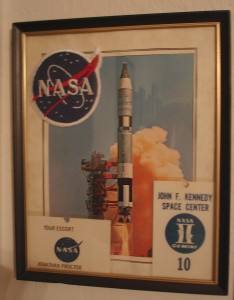
A framed remembrance of the Gemini X launch. That’s a patch off my uniform shirt, name badge and special badge for launch day, surrounding a picture of the Titan II lifting off on July 18, 1966.
The start-up delay was truly a blessing in disguise, giving us much needed time to bone up on the myriad of information in order to conduct tours, and learn how to drive tired old Greyhound buses acquired for the program. In addition, everyone had to go through indoctrination with NASA, receive our ID badges and sign numerous documents. We were also treated to the launch of Gemini X, piloted by Astronauts John Young and Mike Collins, on July 18.
On July 22, the gates were opened for our first day of NASA tours. The public response quickly overwhelmed us: 1,547 people defied rain most of the day to be among the first customers. In fact, the response was so great that five extra buses were commandeered from the General Services Administration (GSA) motor pool; it was all hands on deck, with everyone putting in long hours.
The first week could only be described as controlled mayhem. The old Greyhounds broke down left and right. The biggest problem? Air-conditioning. Buses were observed leaving on tours with the windows closed and returning with them open, a sure sign of A/C failure. We had a staff of mechanics that toiled to keep the vehicles on the road, but with only limited success; our buses were million-milers before we got them.
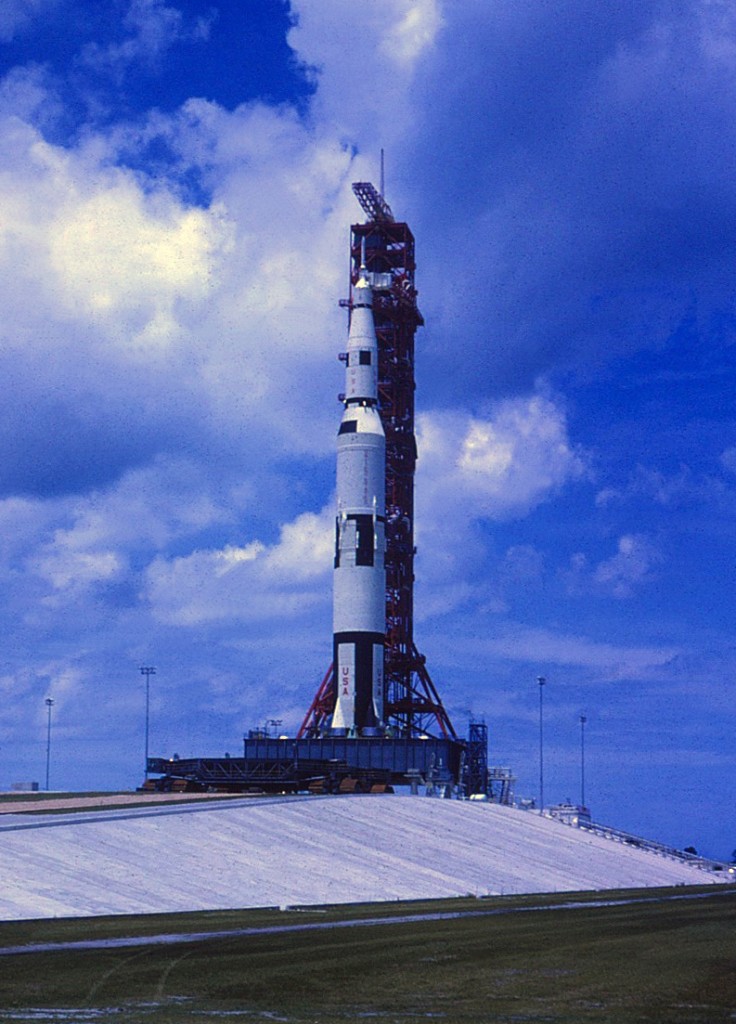
The Saturn V test vehicle was complete except for four of the five engines on the 1st stage. The spacecraft on top was a “boilerplate” version, not a working space vehicle. Standing 40 stories above the ground when resting on its Mobile Launcher, the Moon rocket took your breath away.
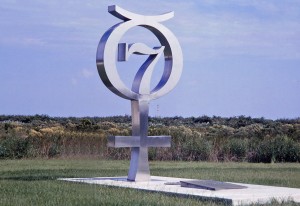
A marker recognizing the seven Mercury astronauts sits alongside the road to Launch Complex 14, barely visible in the distance, where four of the six maned Mercury launches took place.
Another issue was created by the reel-to-reel tape players, located just behind the driver in the overhead rack. They provided a pre-recorded tour narrative, beginning with the loud exclamation, “Welcome; You are on the Threshold of Space!” followed by portions of Fanfare for the Common Man and President John Kennedy’s challenge to put a man on the Moon by the end of the decade. The idea was to give tour escorts support while we learned the words, with a goal of eventually using only the music and quotes. When the recorders and/or public address systems failed early on, escorts were left to ad lib and entertain. Printed copies of the narrative helped, but not much when one was trying to drive a bus at the same time.
Wedding Trip
Even as the tours got off the ground, I had a long-planned trip to Akron, Ohio to complete. My childhood pal, Sam Givens, was marrying Kathryn “Kitzi” Nettling on Saturday, July 23. Time off to make the trip had been granted well in advance thanks to George Friederich. Getting to Akron was another proposition. With the mechanics strike in progress, my half-fare ticket on Eastern Air Lines was not worth the paper it was printed on. Undaunted, I purchased another on Delta, procuring seats on the only available flights. This meant leaving Orlando July 22 at 2:40 a.m. for Atlanta via Tampa. From there, I caught another Delta flight up to Cincinnati, connecting with American to Cleveland. The return trip on Sunday was equally circuitous: Cleveland-Dayton-Cincinnati on American again (a Lockheed Electra for you airliner buffs), then down to Atlanta on a brand-new Delta DC-9 and finally a Delta Convair 880 to Orlando, getting back to the apartment after 3 a.m. I later wrote to Delta and was given a much-appreciated 50% refund on my ticket.
Work Hard, Play Hard
Upon returning to work all too early on Monday morning, I read a notice posted on the employee bulletin board, telling us that all days off had been cancelled until further notice as we expected daily mobs to fill the buses with extra tours scheduled to the extent possible.
The balance of that summer was a whirlwind of working hard and playing hard. The heavily patronized tours continued and kept us busy with plenty of overtime. Evenings found us at the beach, frequenting various restaurants and watering holes. A bonus was the ability to spend some time with brother Dick and family in nearby Winter Park. Niece Penny came over to visit several times and we had a lot of fun.
Various rocket launches were witnessed, including a memorable example on August 26, when a Titan III-C, carrying eight communications satellites, exploded 80 seconds after liftoff, after its second stage failed to ignite. It occurred on my day off and several of us watched its progress from the pool at our apartment complex. Suddenly the rocket blew up, and the noise from that explosion took a few minutes to find its way to our ears.
Only a day earlier we had seen the launch of a Saturn IB rocket, the second stage of which was also used as the third stage on the Saturn V. It was loud and magnificent on its ascent. To see the Titan fail a day later was quite a sobering experience.
Although I enjoyed the Space Center and being geographically close to Dick and family, it was a long way from the airline career I had begun only a few years earlier, and I longed for my old job. Just as I had just about given into the realization that a year’s commitment was going to keep me in Florida for another 10 months, fate stepped in.
Record crowds suddenly began to disappear in late August, as school was about to begin in the region and holiday travelers completed their vacations. Rumors began to circulate about over-staffing. One of the escorts had been told that by paying back original moving expenses he could return to his old job if there were openings there. It was all I needed to hear.
George Friederich confirmed the rumor when I met with him on September 1. They had a surplus of 5-6 escorts, and yes, I could return to LAX if there were openings. I immediately put in a call to Dick Tewell. Dot Schumann answered the phone and told me he was in a meeting, but she would let him know as soon as he was free. Meanwhile, I took out a tour, which I couldn’t wait to return from. When I did, a message from Dick was waiting for me: He had already mailed out a request for my release and how soon could I be back in L.A.?
I told John Steeb a few minutes later, and he made similar arrangements for his return to San Francisco. George wrote a letter stating that we were being moved at company request, which was enough to break our apartment lease, although we lost the deposit.
I managed to ship most of my personal belongings back to LAX via COMAT (Company Material) from the nearest TWA station, Tampa, and was on the road a week later in my VW, headed west via Pascagoula, Mississippi; Dallas, Midland and Tucson. On the second day, a passing truck kicked up a large rock that all but shattered my windshield and scared me silly. I taped it up and limped into Dallas for a replacement, then pressed on, pulling into brother Bill’s driveway September 11, and went back to work at LAX the next day, one happy camper. In the end, none of us who left early had to repay the earlier moving expenses when it was determined that we had been, technically, displaced from the Space Center. TWA later sub-contracted the tour program to another company.
Epilogue
From those original days, NASA Tours has grown to become a major Florida attraction. Modern tour buses took over for those clapped-out Greyhounds and permanent facilities long ago replaced the temporary buildings of 1966. Meanwhile, the price has escalated much like a launch vehicle. Basic admission to the complex today is $45.53. See:
I regret not having returned to KSC to witness a launch of the mighty Saturn V, but did get back in 1967, and naturally I took a tour. Wray Brabson was the escort and we enjoyed reminiscing about the “early days,” such a short time before. Forty years after those first tours, I came back again and took a tour with my good friend, Craig Kodera. Although the tour facility was unrecognizable to me, the old launch complexes out on the Cape appeared to be frozen in time.
If you have an opportunity to visit, be sure to book the “Cape Canaveral, Then and Now” tour, which requires an advance reservation; it’s worth the price.

